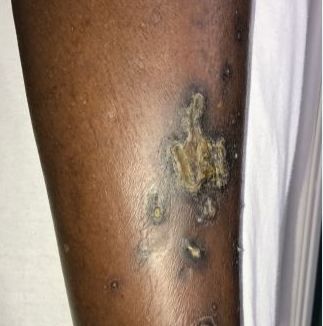- Clinical Technology
- Adult Immunization
- Hepatology
- Pediatric Immunization
- Screening
- Psychiatry
- Allergy
- Women's Health
- Cardiology
- Pediatrics
- Dermatology
- Endocrinology
- Pain Management
- Gastroenterology
- Infectious Disease
- Obesity Medicine
- Rheumatology
- Nephrology
- Neurology
- Pulmonology
Hyperbilirubinemia and Diffuse Skin Lesions in a Woman with Diabetes, CVD
Can you identify the cause of the hyperpigmented umbilicated lesions seen bilaterally on the patient's extremities and on her back?
A 64-year-old woman with a past medical history of hypertension, poorly controlled type 2 diabetes mellitus, hyperlipidemia, and obstructive coronary artery disease with prior stent placement was referred to the hospital by her primary care physician after laboratory testing revealed acutely elevated bilirubin. On evaluation, she reported 3 months of progressive fatigue and decreased exercise tolerance associated with generalized pruritus and jaundice. Vital signs were all within normal range.
Examination of the eyes was remarkable for bilateral scleral icterus. Skin examination revealed hyperpigmented, umbilicated papules with a central core (Figure 1) and larger plaques with central crusting (Figure 2) predominately in the shins, ankles, knees, forearms bilaterally, and back. Lesions were clean-based without surrounding erythema or purulent discharge. Labs were remarkable for a total bilirubin of 17 mg/dL with a direct bilirubin of 9.2 mg/dL, alkaline phosphatase of 1244 U/L, and slight AST elevation. Coagulation profile and balance of the comprehensive metabolic panel was within normal limits. She was admitted for work-up of unexplained hyperbilirubinemia and further evaluation of skin lesions.
Figure1. Hyperpigmented umbilicated papule with central keratotic plug. Figure 2. Koebnerization resulting in large crusted plaque.
Dermatology was consulted for evaluation of diffuse skin lesions. The differential diagnosis included the following.

What is your diagnosis?
